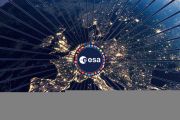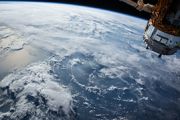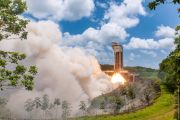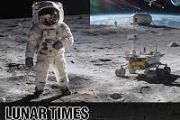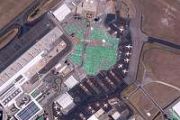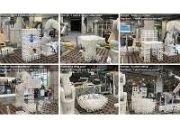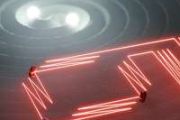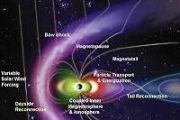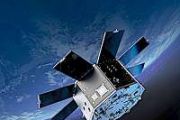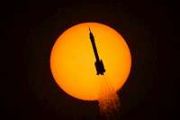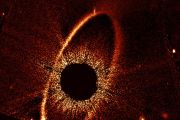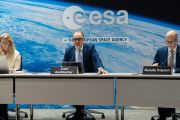
Copernical Team
Decades-old mystery of AlCl dipole moment resolved
 In a study that closes a long-standing knowledge gap in fundamental science, researchers Boerge Hemmerling and Stephen Kane at the University of California, Riverside, have successfully measured the electric dipole moment of aluminum monochloride (AlCl), a simple yet scientifically crucial diatomic molecule. Their results, published in Physical Review A, have implications for quantum technologie
In a study that closes a long-standing knowledge gap in fundamental science, researchers Boerge Hemmerling and Stephen Kane at the University of California, Riverside, have successfully measured the electric dipole moment of aluminum monochloride (AlCl), a simple yet scientifically crucial diatomic molecule. Their results, published in Physical Review A, have implications for quantum technologie Unexpected Dust Patterns Found on Uranus Moons Confound Scientists
 Scientists using NASA's Hubble Space Telescope set out to detect radiation-induced surface changes on Uranus' largest moons but uncovered a different phenomenon altogether.
The team had hypothesized that charged particles from Uranus' magnetosphere would darken the trailing hemispheres of its four major moons-Ariel, Umbriel, Titania, and Oberon-due to constant bombardment. These moons are
Scientists using NASA's Hubble Space Telescope set out to detect radiation-induced surface changes on Uranus' largest moons but uncovered a different phenomenon altogether.
The team had hypothesized that charged particles from Uranus' magnetosphere would darken the trailing hemispheres of its four major moons-Ariel, Umbriel, Titania, and Oberon-due to constant bombardment. These moons are ESA Flyeye telescope begins full sky survey for asteroid detection
 The European Space Agency's Flyeye telescope has officially commenced operations, capturing its first celestial images and marking a significant advancement in the detection of near-Earth asteroids and comets.
Engineered with a unique compound-eye-inspired design, Flyeye was developed by ESA and OHB Italia to monitor a sky area over 200 times the size of the full Moon in a single shot. Thi
The European Space Agency's Flyeye telescope has officially commenced operations, capturing its first celestial images and marking a significant advancement in the detection of near-Earth asteroids and comets.
Engineered with a unique compound-eye-inspired design, Flyeye was developed by ESA and OHB Italia to monitor a sky area over 200 times the size of the full Moon in a single shot. Thi Why the moon shimmers with shiny glass beads
 The Apollo astronauts didn't know what they'd find when they explored the surface of the moon, but they certainly didn't expect to see drifts of tiny, bright orange glass beads glistening among the otherwise monochrome piles of rocks and dust.
The beads, each less than 1 mm across, formed some 3.3 to 3.6 billion years ago during volcanic eruptions on the surface of the then-young satellite
The Apollo astronauts didn't know what they'd find when they explored the surface of the moon, but they certainly didn't expect to see drifts of tiny, bright orange glass beads glistening among the otherwise monochrome piles of rocks and dust.
The beads, each less than 1 mm across, formed some 3.3 to 3.6 billion years ago during volcanic eruptions on the surface of the then-young satellite PLD Space advances MIURA 5 launch capability with TEPREL C engine tests
 PLD Space has reached a critical milestone in the development of its MIURA 5 orbital launcher by completing integrated testing of its TEPREL-C rocket engines. This progress marks a significant step toward the start of the engine's flight qualification campaign, which is slated to begin at the end of June.
The Spanish aerospace company emphasizes propulsion as the foundation of its technolo
PLD Space has reached a critical milestone in the development of its MIURA 5 orbital launcher by completing integrated testing of its TEPREL-C rocket engines. This progress marks a significant step toward the start of the engine's flight qualification campaign, which is slated to begin at the end of June.
The Spanish aerospace company emphasizes propulsion as the foundation of its technolo Rocket Lab completes eighth Electron launch of 2025 deploying fifth iQPS satellite
 Rocket Lab has successfully executed its 66th Electron mission, deploying the QPS-SAR-11 satellite for the Institute for Q-shu Pioneers of Space (iQPS). The launch marks Rocket Lab's second mission for iQPS in just 25 days and its fourth overall, all completed with full mission success.
Lifting off from Launch Complex 1 in Mahia, New Zealand at 15:31 UTC on June 11, the mission-titled "The
Rocket Lab has successfully executed its 66th Electron mission, deploying the QPS-SAR-11 satellite for the Institute for Q-shu Pioneers of Space (iQPS). The launch marks Rocket Lab's second mission for iQPS in just 25 days and its fourth overall, all completed with full mission success.
Lifting off from Launch Complex 1 in Mahia, New Zealand at 15:31 UTC on June 11, the mission-titled "The The proposed NASA budget cuts would decimate American science, an expert says
This request seems a bit unusual, so we need to confirm that you're human. Please press and hold the button until it turns completely green. Thank you for your cooperation!
Press and hold the button
If you believe this is an error, please contact our support team.
185.132.36.159 : 13737fce-ce82-4dd1-8814-3e2f0ab3
Solar Orbiter gets world-first views of the Sun’s south pole
 Video:
00:01:55
Video:
00:01:55
What if we could look at the Sun from a whole new angle, one we've never seen before?
From Earth, we always look towards the Sun's equator. This year, the ESA-led Solar Orbiter mission broke free of this ‘standard’ viewpoint by tilting its orbit to 17° – out of the ecliptic plane where the planets and all other Sun-watching spacecraft reside. Now for the first time ever, we can clearly see the Sun’s unexplored poles.
Using different instruments, Solar Orbiter can see what happens throughout the Sun's outer layers. The material in these layers never stays still, being
BlackSky Gen-3 delivers very hi-res imagery at warfighting speed - 12 hours after launch
 BlackSky Technology Inc. (NYSE: BKSY) has delivered the first very high-resolution images from the company's second Gen-3 satellite just 12 hours following its successful launch last Monday.
"In today's national security environment, BlackSky's customers require space-based intelligence that moves at warfighter speed," said Brian O'Toole, BlackSky CEO. "BlackSky's newest Gen-3 satellite ha
BlackSky Technology Inc. (NYSE: BKSY) has delivered the first very high-resolution images from the company's second Gen-3 satellite just 12 hours following its successful launch last Monday.
"In today's national security environment, BlackSky's customers require space-based intelligence that moves at warfighter speed," said Brian O'Toole, BlackSky CEO. "BlackSky's newest Gen-3 satellite ha China testing orbital refueling procedures for satellite missions
 China is positioning a satellite to test its ability to refuel another in orbit over Earth and extend its mission for several more years.
China's Shijian-25 satellite is designed to refuel and service other satellites while they stay in geostationary orbit over Earth, SpaceNews reported.
A geostationary orbit is one in which a satellite or another spacecraft maintains its locatio
China is positioning a satellite to test its ability to refuel another in orbit over Earth and extend its mission for several more years.
China's Shijian-25 satellite is designed to refuel and service other satellites while they stay in geostationary orbit over Earth, SpaceNews reported.
A geostationary orbit is one in which a satellite or another spacecraft maintains its locatio 





